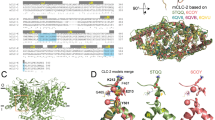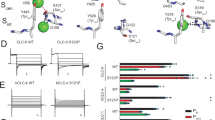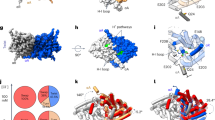Abstract
Chloride channels and transporters of the CLC gene family are expressed in virtually all cell types and are crucial in the regulation of membrane potential, chloride homeostasis and intravesicular pH. There are two gating processes that open CLC channels—fast and slow. The fast gating process in CLC channels has recently been linked to a small movement of a glutamate side chain. However, the molecular mechanism underlying the slow gating process is still elusive. Using spectroscopic microscopy, we observed a large backbone movement in the C terminus of the CLC-0 chloride channel that was functionally linked to slow gating. We further showed that the C-terminal movement had a time course similar to slow gating. In addition, a mutation known to lock the slow gate open prevented movement of the C terminus. When combined with recent structural information on the CLC C terminus, our findings provide a structural model for understanding the conformational changes linked to slow gating in CLC transport proteins.
This is a preview of subscription content, access via your institution
Access options
Subscribe to this journal
Receive 12 print issues and online access
$189.00 per year
only $15.75 per issue
Buy this article
- Purchase on Springer Link
- Instant access to full article PDF
Prices may be subject to local taxes which are calculated during checkout




Similar content being viewed by others
References
Jentsch, T.J., Steinmeyer, K. & Schwarz, G. Primary structure of Torpedo marmorata chloride channel isolated by expression cloning in Xenopus oocytes. Nature 348, 510–514 (1990).
Chen, T.Y. Structure and function of clc channels. Annu. Rev. Physiol. 67, 809–839 (2005).
Jentsch, T.J., Neagoe, I. & Scheel, O. CLC chloride channels and transporters. Curr. Opin. Neurobiol. 15, 319–325 (2005).
Miller, C. ClC chloride channels viewed through a transporter lens. Nature 440, 484–489 (2006).
Pusch, M. & Jentsch, T.J. Unique structure and function of chloride transporting CLC proteins. IEEE Trans. Nanobioscience 4, 49–57 (2005).
Dutzler, R., Campbell, E.B. & MacKinnon, R. Gating the selectivity filter in ClC chloride channels. Science 300, 108–112 (2003).
Accardi, A. et al. Separate ion pathways in a Cl−/H+ exchanger. J. Gen. Physiol. 126, 563–570 (2005).
Miller, C. & White, M.M. A voltage-dependent chloride conductance channel from Torpedo electroplax membrane. Ann. NY Acad. Sci. 341, 534–551 (1980).
Chen, T.Y. & Miller, C. Nonequilibrium gating and voltage dependence of the ClC-0 Cl− channel. J. Gen. Physiol. 108, 237–250 (1996).
Fong, P., Rehfeldt, A. & Jentsch, T.J. Determinants of slow gating in ClC-0, the voltage-gated chloride channel of Torpedo marmorata. Am. J. Physiol. 274, C966–C973 (1998).
Estevez, R., Pusch, M., Ferrer-Costa, C., Orozco, M. & Jentsch, T.J. Functional and structural conservation of CBS domains from CLC chloride channels. J. Physiol. (Lond.) 557, 363–378 (2004).
Hebeisen, S. et al. The role of the carboxyl terminus in ClC chloride channel function. J. Biol. Chem. 279, 13140–13147 (2004).
Glauner, K.S., Mannuzzu, L.M., Gandhi, C.S. & Isacoff, E.Y. Spectroscopic mapping of voltage sensor movement in the Shaker potassium channel. Nature 402, 813–817 (1999).
Cha, A., Snyder, G.E., Selvin, P.R. & Bezanilla, F. Atomic scale movement of the voltage-sensing region in a potassium channel measured via spectroscopy. Nature 402, 809–813 (1999).
Posson, D.J., Ge, P., Miller, C., Bezanilla, F. & Selvin, P.R. Small vertical movement of a K+ channel voltage sensor measured with luminescence energy transfer. Nature 436, 848–851 (2005).
Chanda, B., Asamoah, O.K., Blunck, R., Roux, B. & Bezanilla, F. Gating charge displacement in voltage-gated ion channels involves limited transmembrane movement. Nature 436, 852–856 (2005).
Lakowicz, J. Principles of Fluorescence Spectroscopy 725 (Plenum, New York, 1999).
Selvin, P.R. The renaissance of fluorescence resonance energy transfer. Nat. Struct. Biol. 7, 730–734 (2000).
Stryer, L. & Haugland, R.P. Energy transfer: a spectroscopic ruler. Proc. Natl. Acad. Sci. USA 58, 719–726 (1967).
Stryer, L. Fluorescence energy transfer as a spectroscopic ruler. Annu. Rev. Biochem. 47, 819–846 (1978).
Rizzo, M.A., Springer, G.H., Granada, B. & Piston, D.W. An improved cyan fluorescent protein variant useful for FRET. Nat. Biotechnol. 22, 445–449 (2004).
Heim, R. & Tsien, R.Y. Engineering green fluorescent protein for improved brightness, longer wavelengths and fluorescence resonance energy transfer. Curr. Biol. 6, 178–182 (1996).
Takanishi, C.L., Bykova, E., Cheng, W. & Zheng, J. Quantification of GFP-based FRET in transfected cells. Brain Res. 1091, 132–139 (2006).
Zheng, J. Spectroscopy-based quantitative fluorescence resonance energy transfer analysis. Methods Mol. Biol. 337, 65–78 (2006).
Zheng, J., Trudeau, M.C. & Zagotta, W.N. Rod cyclic nucleotide-gated channels have a stoichiometry of three CNGA1 subunits and one CNGB1 subunit. Neuron 36, 891–896 (2002).
Dutzler, R., Campbell, E.B., Cadene, M., Chait, B.T. & MacKinnon, R. X-ray structure of a ClC chloride channel at 3.0 Å reveals the molecular basis of anion selectivity. Nature 415, 287–294 (2002).
Meyer, S. & Dutzler, R. Crystal structure of the cytoplasmic domain of the chloride channel ClC-0. Structure 14, 299–307 (2006).
Chen, T.Y. Extracellular zinc ion inhibits ClC-0 chloride channels by facilitating slow gating. J. Gen. Physiol. 112, 715–726 (1998).
Lin, Y.W., Lin, C.W. & Chen, T.Y. Elimination of the slow gating of ClC-0 chloride channel by a point mutation. J. Gen. Physiol. 114, 1–12 (1999).
Miller, C. & White, M.M. Dimeric structure of single chloride channels from Torpedo electroplax. Proc. Natl. Acad. Sci. USA 81, 2772–2775 (1984).
Pusch, M., Ludewig, U. & Jentsch, T.J. Temperature dependence of fast and slow gating relaxations of ClC-0 chloride channels. J. Gen. Physiol. 109, 105–116 (1997).
Bennetts, B., Roberts, M.L., Bretag, A.H. & Rychkov, G.Y. Temperature dependence of human muscle ClC-1 chloride channel. J. Physiol. (Lond.) 535, 83–93 (2001).
Jordt, S.E., McKemy, D.D. & Julius, D. Lessons from peppers and peppermint: the molecular logic of thermosensation. Curr. Opin. Neurobiol. 13, 487–492 (2003).
Zagotta, W.N. et al. Structural basis for modulation and agonist specificity of HCN pacemaker channels. Nature 425, 200–205 (2003).
Simon, D.B. et al. Mutations in the chloride channel gene, CLCNKB, cause Bartter's syndrome type III. Nat. Genet. 17, 171–178 (1997).
Haug, K. et al. Mutations in CLCN2 encoding a voltage-gated chloride channel are associated with idiopathic generalized epilepsies. Nat. Genet. 33, 527–532 (2003).
Steinmeyer, K. et al. Inactivation of muscle chloride channel by transposon insertion in myotonic mice. Nature 354, 304–308 (1991).
Lloyd, S.E. et al. A common molecular basis for three inherited kidney stone diseases. Nature 379, 445–449 (1996).
He, L., Denton, J., Nehrke, K. & Strange, K. Carboxy terminus splice variation alters ClC channel gating and extracellular cysteine reactivity. Biophys. J. 90, 3570–3581 (2006).
Schmidt-Rose, T. & Jentsch, T.J. Reconstitution of functional voltage-gated chloride channels from complementary fragments of CLC-1. J. Biol. Chem. 272, 20515–20521 (1997).
Acknowledgements
We are grateful to D. Piston (Vanderbilt University), R. Tsien (University of California at San Diego) and I. Kojima (Gunma University) for the kind gifts of Cerulean, EYFP and mTRPV2, respectively. We also thank E. Lachica (Olympus USA) for support of the Spectra FRET imaging system and W. Cheng, C. Takanishi and W.-P. Yu for technical assistance. This work was supported by grants from the American Heart Association (0665201Y to J.Z.) and the US National Institutes of Health (R01-GM065447 to T.-Y.C.).
Author information
Authors and Affiliations
Corresponding author
Ethics declarations
Competing interests
The authors declare no competing financial interests.
Rights and permissions
About this article
Cite this article
Bykova, E., Zhang, XD., Chen, TY. et al. Large movement in the C terminus of CLC-0 chloride channel during slow gating. Nat Struct Mol Biol 13, 1115–1119 (2006). https://doi.org/10.1038/nsmb1176
Received:
Accepted:
Published:
Issue Date:
DOI: https://doi.org/10.1038/nsmb1176
This article is cited by
-
Structural basis of pH-dependent activation in a CLC transporter
Nature Structural & Molecular Biology (2024)
-
Quantifying macromolecular interactions in living cells using FRET two-hybrid assays
Nature Protocols (2016)
-
X-exome sequencing of 405 unresolved families identifies seven novel intellectual disability genes
Molecular Psychiatry (2016)
-
Conformational changes required for H+/Cl− exchange mediated by a CLC transporter
Nature Structural & Molecular Biology (2014)
-
Molecular determinants of common gating of a ClC chloride channel
Nature Communications (2013)



